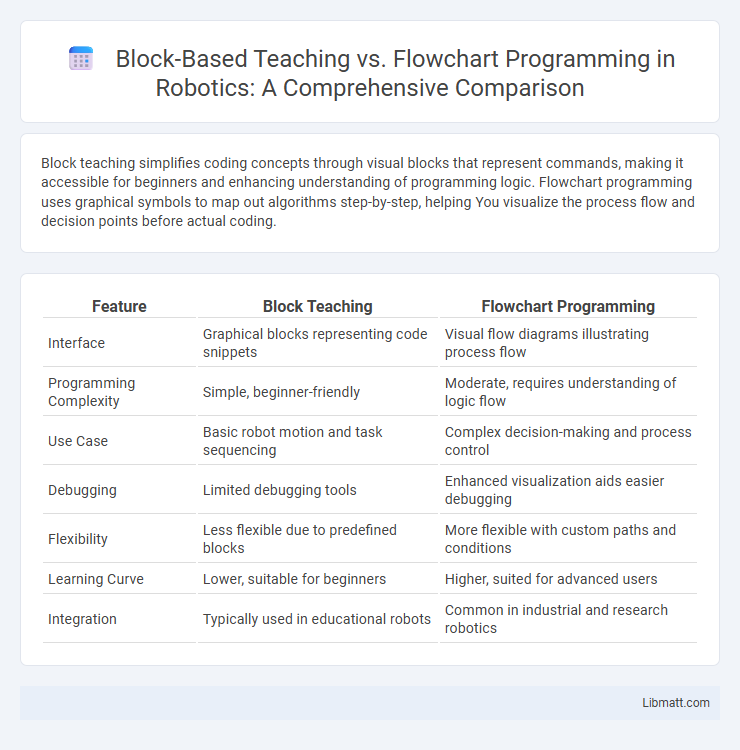Block teaching simplifies coding concepts through visual blocks that represent commands, making it accessible for beginners and enhancing understanding of programming logic. Flowchart programming uses graphical symbols to map out algorithms step-by-step, helping You visualize the process flow and decision points before actual coding.
Table of Comparison
| Feature | Block Teaching | Flowchart Programming |
|---|---|---|
| Interface | Graphical blocks representing code snippets | Visual flow diagrams illustrating process flow |
| Programming Complexity | Simple, beginner-friendly | Moderate, requires understanding of logic flow |
| Use Case | Basic robot motion and task sequencing | Complex decision-making and process control |
| Debugging | Limited debugging tools | Enhanced visualization aids easier debugging |
| Flexibility | Less flexible due to predefined blocks | More flexible with custom paths and conditions |
| Learning Curve | Lower, suitable for beginners | Higher, suited for advanced users |
| Integration | Typically used in educational robots | Common in industrial and research robotics |
Introduction to Block Teaching and Flowchart Programming
Block teaching introduces programming through visual, drag-and-drop code blocks that simplify syntax and logic understanding for beginners. Flowchart programming represents processes with graphical symbols and arrows, emphasizing step-by-step logic and decision-making paths. Your choice between block teaching and flowchart programming depends on whether you prioritize hands-on coding practice or visual process mapping.
Definitions and Core Concepts
Block teaching uses visual, drag-and-drop interfaces to introduce programming concepts, emphasizing modular learning and intuitive code construction for beginners. Flowchart programming represents algorithms through graphical symbols and flow lines, highlighting logical process flows and decision-making paths in program design. Both methods prioritize clarity and user-friendly structures but cater to different stages of computational thinking development.
Historical Development and Adoption
Block teaching originated in the early 20th century as an educational method dividing curriculum into focused units to improve student comprehension, gaining widespread adoption in K-12 systems by the mid-1900s. Flowchart programming emerged in the 1950s alongside the rise of computer science, with flowcharts providing a visual representation of algorithms to streamline coding and debugging, becoming integral to software engineering education and development processes. The adoption of block teaching emphasized pedagogical structure, while flowchart programming focused on algorithmic clarity, each influencing modern educational and programming frameworks differently.
Pedagogical Approaches Compared
Block teaching emphasizes hands-on, visual learning by allowing students to manipulate code blocks, which simplifies complex programming concepts and supports iterative learning. Flowchart programming prioritizes logical sequencing and visual representation of algorithms, fostering analytical thinking and structured problem-solving skills. Both approaches enhance comprehension by breaking down abstract programming ideas, but block teaching tends to be more accessible for beginners while flowcharts cultivate early algorithmic reasoning.
Visual Representation in Learning
Block teaching provides students with an intuitive visual representation by using drag-and-drop code blocks that clearly depict programming logic and structure, making complex concepts easier to grasp. Flowchart programming visually maps out the sequence of operations and decision points in a process, offering a step-by-step guide that enhances understanding of algorithmic flow. You benefit from these visual tools as they improve cognitive retention and simplify the debugging of code by representing logic in a straightforward, accessible manner.
Advantages of Block Teaching
Block teaching enhances learning by simplifying complex programming concepts into intuitive, visual elements, making it easier for beginners to grasp foundational skills. This method reduces syntax errors, allowing learners to focus on logical thought processes and problem-solving without the frustration of code debugging. By promoting interactive engagement and immediate visual feedback, block teaching effectively supports your retention and understanding of programming principles.
Benefits of Flowchart Programming
Flowchart programming offers clear visualization of the program's logic, making complex processes easier to understand and debug. It enhances communication between developers and stakeholders by providing a straightforward graphical representation of workflows. Your team benefits from improved planning and error detection early in development, reducing the risk of costly mistakes later on.
Challenges and Limitations
Block teaching faces challenges such as limited depth in coding concepts and reduced exposure to syntax nuances, which may hinder advanced programming skills development. Flowchart programming can become overly complex and hard to maintain with large-scale projects, leading to difficulties in debugging and scalability. Your choice between the two should consider these limitations in terms of learning curve and project requirements.
Practical Applications in Education
Block teaching enhances practical learning in education by simplifying coding concepts through visual programming environments like Scratch and Blockly, enabling students to grasp logic without syntax errors. Flowchart programming, often used in algorithm design and problem-solving, helps learners develop structured thinking by visually mapping process steps before coding in languages like Python or Java. Your education benefits from integrating block teaching for foundational skills and flowchart programming for understanding complex workflows and decision-making processes.
Choosing the Right Method: Factors to Consider
Choosing the right method between block teaching and flowchart programming depends on the learner's familiarity with programming concepts and the complexity of the task. Block teaching suits beginners by offering visual and interactive coding elements, enhancing comprehension through drag-and-drop interfaces, while flowchart programming is ideal for illustrating logical processes and helping users structure algorithms step-by-step. Consider factors such as educational objectives, user engagement level, and the need for abstract thinking when selecting the most effective programming instruction approach.
Block teaching vs Flowchart programming Infographic

 libmatt.com
libmatt.com